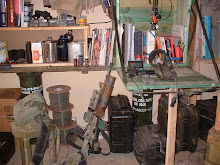
This painting is renowned for three elements: its colossal size (11'10" X 14'4"), the effective use of light and shadow, and the perception of motion in what would traditionally have been a static military portrait.
Completed in 1642 at the peak of the Dutch Golden Age, it was customary during this time for military units to commission an artist to execute a group portrait. During this time military forces were commercial operations; true mercenaries. A man who hired himself to one of these private military companies was known as a "private soldier" - these are the origins of the military terms "company" and "private".
Commissioned by the Company's Commanding Officer and 17 members of his Kloveniers (civic militia guards), a total of 34 characters appear in the painting; Rembrandt was paid 1,600 guilders for the painting (each person paid one hundred), a large sum at the time.
The Night Watch depicts the eponymous company moving out, led by Captain Frans Banning Cocq (dressed in black, with a red sash) and his lieutenant, Willem van Ruytenburch (dressed in yellow, with a white sash). With effective use of sunlight and shade, Rembrandt leads the eye to the three most important characters among the crowd, the two gentlemen in the center (from whom the painting gets its original title), and the small girl in the center left background. Behind them the company's colors are carried by the ensign, Jan Visscher Cornelissen.
The militiamen were also called Arquebusiers, after the arquebus, a sixteenth-century long-barreled gun.
Rembrandt has displayed the traditional emblem of the Arquebusiers in the painting in a natural way: the girl in yellow dress in the background is carrying the main symbols. She is a kind of mascot herself: the claws of a dead chicken on her belt represent the clauweniers (arquebusiers); the pistol behind the chicken stands for 'clover'; and, she is holding the militia's goblet. The man in front of her is wearing a helmet with an oak leaf, a traditional motif of the Arquebusiers. The dead chicken is also meant to represent a defeated adversary. The color yellow was at that time often associated with victory.
The painting was commissioned to be hung in the banquet hall of the newly built Kloveniersdoelen (Musketeers' Meeting Hall) in Amsterdam, now known as the Doelen Hotel. In 1715 it was moved to the Amsterdam town hall. When Napoleon occupied the Netherlands, the town hall became the Palace on the Dam. The magistrates moved the painting to the Trippenhuis of the family Trip. Napoleon ordered it back, but after the occupation the painting was moved to the Trippenhuis again, which had now become the Rijksmuseum, and was moved to the new Rijksmuseum building when it was finished in 1885.
The painting was last moved in September 1939, just before the outbreak of the Second World War. The canvas was detached from its frame, rolled around a cylinder, and stored in a castle in Medemblik, north of Amsterdam.
After the end of the war, the canvas was unrolled, re-mounted and restored; and then the Night Watch returned to its rightful place in the Rijksmuseum where it is on prominent display; the most famous painting in their collection.
.













































No comments:
Post a Comment